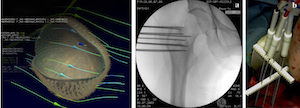Purpose:
Electrochemotherapy is effective in treatment of various cutaneous tumors and could be translated into treatment of deep seated tumors. With this aim, a prospective clinical phase I/II study was conducted to evaluate feasibility, safety and efficacy of intraoperative Electrochemotherapy (ECT) in locally advanced pancreatic adenocarcinoma. Secondary endpoint was to evaluate treatment response in terms of quantitative morphological and functional criteria based on Magnetic Resonance Imaging.
Methods: Twelve consecutive patients were enrolled, recruited in a clinical phase I/II study approved by Ethical Committee of National Cancer Institute G. Pascale Foundation- IRCCS of Naples. Electrochemotherapy with bleomycin was performed during open surgery, by insertion of electrodes into and around the tumor according to the individualized treatment plan. All patients underwent MR and CT scan, before and after ECT treatment, using morphological and functional imaging. RECIST criteria were used to evaluate ECT response on TC images and quantitative parameters were used to evaluate ECT response on MR images.
Results: No acute (intraoperative) and/or postoperative serious adverse events related to electrochemotherapy were observed; no clinically significant electrocardiographic, hemodynamic, or serum biologic changes were noted. No clinically relevant elevation of amylase or lipase levels was observed in any patient and no bleeding or damage to surrounding viscera occured. Functional imaging based on MR has shown more suitable to evaluate ECT response in patients with locally advanced pancreatic adenocarcinoma than TC imaging.
Conclusions: Electrochemotherapy of locally advanced pancreatic adenocarcinoma proved to be feasible, safe and effective treatment modality. Dynamic and diffusion MR imaging is more suitable to assess ECT treatment response than TC imaging.

 PDF version
PDF version
